Updated: 31-Aug-2023
Rotax in Austria is a manufacturer of engines for motorcycles, snowmobiles and jet skis (water jets).
-It dedicated itself to the beginning of the proliferation of ULM, VLA and motorized hang gliders to the construction of special engines for these new air vehicles.
-It entered after the Cuyunas (pioneers) and many others and has ended up monopolizing the market, so much, that it is easy to find most of these small airplanes with Rotax engines.
-The first engine -adapted- was the 128 cc single-cylinder that gave 9.5 CV, and was installed on the ULM Lazair II. Later the 277.

“Rotax 277”
-And the 277 was already adapted for ULM, with reduction gear as shown in the illustration below.
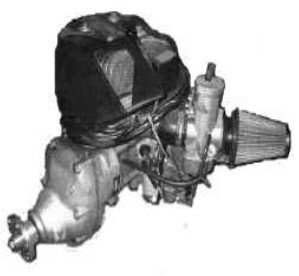
“Rotax 277 with reduction gear”
-The single-cylinder, 2-stoke 277 engine can be inverted, and is forced air cooled. It displaces 268 cc and gives 25 CV.
Its reduction gear seems being the same for all engines
-Almost all Rotax achieve maximum power at 6,500 rpm and maximum at 6,800, except the four-cylinder 912 and 914 that do so at 5,500/5,800 rpm, respectively.
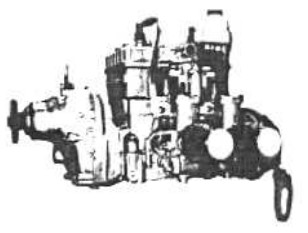
“Rotax 532, upright gearbox”
-The gearboxes are positionable, upright, to raise the propeller off the ground, or inverted downwards to lower the drive shaft if the motor is placed in a high position. For example, on top of an upper wing.
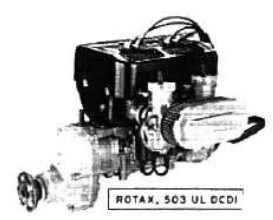
“Rotax 503, inverted gearbox”
-In twin-cylinder engines, they can have one or two carburetors.
-The ignition can also be single or double, depending on the model.
-Another general characteristic was that these versions could be obtained with air-cooling or liquid-cooling by a radiator.

“Rotax 503, with a single carburetor”
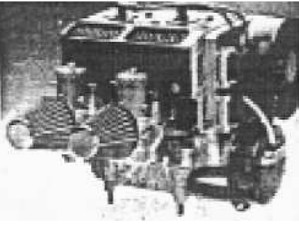
“Rotax 503, with two carburetors”
-It is mentioned that some models have liquid-cooled cylinder heads and air-cooled cylinders.

“503, fan side”
-In air cooling there is usually a fan to force it towards the cylinders and heads. For this reason they use covers and deflectors.

“582, with two radiators”
-In the general production of Rotax we see the two single-cylinder engines mentioned at the beginning.
Currently the main bulk of production are the two-cylinder models 377, 447, 462, 501, 503, 508, 532 and 582.
-All are 2-stroke except the 508, which is 4-stroke.
-The 912 and 914 engines that we will see towards the endof this chapter are also 4-stroke.
-Historically in the brand, before the 377 there was the 300. This engine had a displacement of 300 cc and gave 28 CV with two in-line cylinders.

“Rotax 377, with Flexidyne”
-The 377 is similar to the 300 except the increase in displacement. It had a Mikuni carburetor and Bosch ignition giving 34 CV.

“377 air cooled”
-Both could go with transmission and Flexidyne clutch, as we see in a photograph above.

“Rotax 447”
-The 40 cv 447 appears here with a single carburetor and without a filter.
-As in most Rotax engines, it has a recoil starter.
-As we can see, the 447 also has the possibility of having a positional gearbox.
-Both engines have single-ignition with a spark plug for each cylinder.
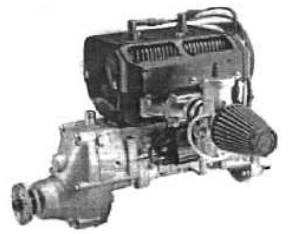
“Rotax 447 with inverted gearbox”
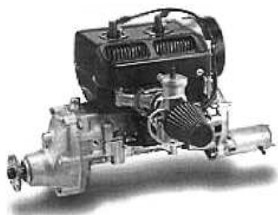
“El 447 UL with electric starter”
-The electric starter motor is located at the rear of the engine, rather low.

“Rotax 462”
-The 462, displacement number in cc, gave 51 CV. Instead of the simple ports that uncovered the pistons and communicated directly with the carburetor, it has a rotary valve. Note that certain engines have carburetors at the height of the cylinders and others have them lower, on the crankcase.
-The 463, derived from the previous one, like the 501, is quite unknown, with 43 CV, it is the predecessor of the 503. The latter one, with 45 CV, can reach 50 CV in the UL-2V version with electronic ignition and at 6,800 rpm.
-First we show an earlier model, air cooled, with belt gear and a toothed plate for the electric starter. It is the exhaust side.

“Rotax 503”

“503UL DCDI”
-This 503, with a displacement of 496.7 cc, has a new gearbox and two carburetors giving 50 CV. It has a single carburetor and gives 46 CV.
-We come to the 508, whose interest is that it uses the 4-stroke cycle, which makes the engine taller with cylinder head valves.
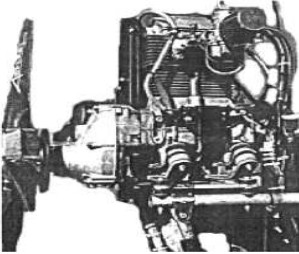
"Rotax 508 installation”
-As we can see, the carburetor is located in the upper part of the cylinders, next to the intake valves.

“The 508 is a higher engine”
-The power was 43 CV achieved at 7,800 rpm. Fuel consumption drops considerably as it is a four-stroke, instead of the other 2-stroke engines.
-The 532, already reached 64 HP, all this series is liquid cooled and has rotary valves.

"Rotax 532"
-There was the 535 engine without data at this time. The 582 (together with the 618) is one of the largest liquid-cooled in-line twins, giving 65 CV. The 90 and 99 models are standing out. The latter is recognized for its blue cylinder heads.
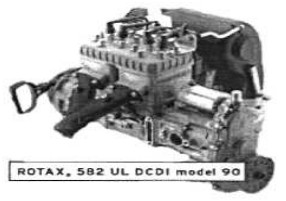
“Rotax 582”
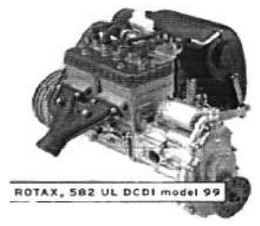
“Rotax 582, blue cylinder head”
-The 618 in-line cylinder, model UL-2V could give 73 CV.
-It is liquid cooled, with water pump and thermostat, and it has a silent intake.
-It has a large gearbox and double ignition, with two Bing carburetors. It is out of production.

“Rotax 618”
-We now come to the outstanding "horizontal four cylinders", the 912 and 914 that give 80/85 CV respectively at 5,500 rpm. They can rotate at 5,800 rpm, at takeoff power, for a maximum of 5 minutes.
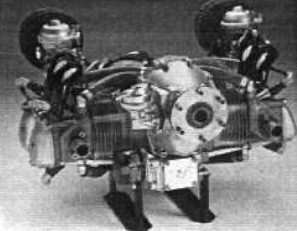
“An early 912 engine”

“Another early 912 engine”
-They are mounted on VLA aircraft, such as Dimona, Tecnam. etc. It has a displacement of 1211 cc and weighs about 60 kg. It has liquid-cooled cylinder heads and air-cooled cylinders.
-Currently they have a pulley on the propeller plate for an accessory such as an alternator.
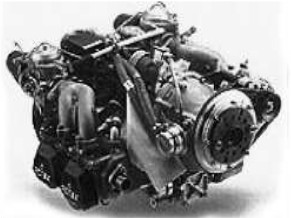
“Rotax 912UL DCDI”
-The 912UL gives 79 cv at 5,500 rpm (81 cv at 5,800 for 5 minutes at takeoff). It displaced 73.91 cu. in.
-The 912ULS, gives 95 cv at 5,500 rpm (100 cv takeoff power at 5,800 for only 5 minutes). It displaces 82.6 cu. in. or 1352 cc. It seems that there was a 906 with two horizontally opposed cylinders giving 35 CV at 6,000 rpm, and was built between 1985 and 1986. They were air-cooled and had reduction gear with four possible ratios. It was shown at EAA Oshkosh
-It seems that those offered now are 447UL, 503UL, 582UL, 912UL / A / F / ULS and S. And 914 UL and F.
-It is also news that Rotax now belongs to the Bombardier group, BRP = Bombardier Recreational Products.
-As projects in development, there are V-6 models, V220 and V300T, with 220 and 300 CV respectively.

“Rotax 6-cylinder Vee”
From Appendix 6: We can show an application of the Rotax 185 that does not appear in the main text.

“Rotax 185 single-cylinder engine”
-In 2009, the Rotax 914 with turbocharger was presented at the Aerosport of Igualada, in the province of Barcelona, Spain.
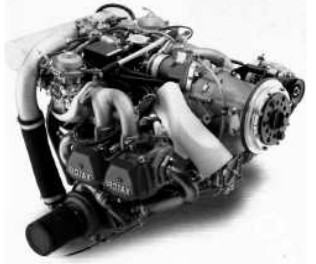
“914 UL 3-DCDI with options”
-The turbocharger is located below the engine with automatic turbo speed control through a discharge derived from the exhaust (waste gate).
-The power was 115 CV with a limitation of 5 minutes at 5,800 rpm. The turbo serves to maintain power at high altitudes.
-With two “forced-air” carburetors, double electronic ignition, electric starter, PSRU reducer.
-References for the Waste Gate, ignition, etc. They are taken from the “Upper Deck” or upper chamber at the turbo outlet, which is located in the upper rear part of the engine. It acts as a compressed air reserve. A duct visible from the turbo outlet rises to said chamber.
-In the main text there is a 582 with blue cylinder heads due to the color of anodizing.
-It has two cylinders and two-stroke cycle, and its main characteristic is having a large disc-type rotary valve located between the two cylinders on the left side driven by a shaft that is transverse to the engine. At the right end of this same shaft is the water pump.

“Rotax 582, model 99”
From Appendix 10: From the Bombadier group (BRP = Bombardier Recreational Products).
-With the new times of hybrid engines, combustion/electric propulsion, this brand has also made a prototype in 2005. It consists of a 914 engine to which an Ashot electric motor and a lithium battery has been coupled. It is the new HPS.
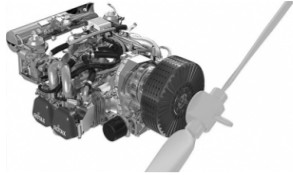
“The electric motor is black”
-The electric motor is sandwiched between the gearbox and the propeller. It seems like an ideal solution.
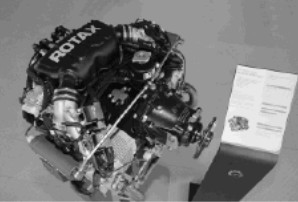
“The 912isS (Sport) is also presented”
-The new 912 has a different and distinguishable intake manifold.
-Since the appearance of the engines in the main text until today there have been technical developments, mainly for the ignition and fuel supply.
-The first case is the one mentioned recently about the twin-cylinder 582, Mod. 99 on which a double electronic ignition (DCDI) was installed.

“Variant of 582 UL, double ignition”
-We see an electric starter under the gearbox (in addition to the flywheel for the recoil starter, at the rear of the engine).
-In the previous example of this engine, the electrical starter is behind the propeller shaft.
-Of the small two-stroke engines, the 582 UL is the most prevalent in the Rotax catalogues.
-Another thing is that of the immediately superior powers. So we move on to the four cylinder, four stroke engines with boxer cylinders, that is, horizontally opposed.
-The 912 UL is the basic one of this range. It has reduction gear, electric starter, with integrated gear (and another optional one upon request).
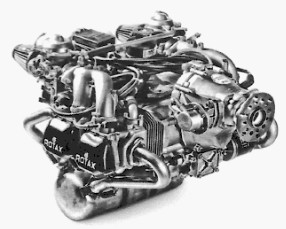
“Rotax 912 UL2”
-There is a UL2 version (not certified) giving 78/80 CV at 5,500 rpm.
-These engines are water cooled at the cylinder heads and air cooled at the cylinders by fins. They have two carburetors.
-The UL3 variant has the possibility of installing a governor for the propeller and friction clutch.

“Rotax 912 ULS”
-The 912 series also has ULS2 and ULS3 versions, varying in engine equipment.
-The power of these engines rises to 95/100 CV depending on whether they run at 5,500 or 5,800 rpm. At the latter rpm they can only run for 5 minutes.

“Rotax 912 iS Sport”
-The Rotax 912 iS Sport gives 95/100 CV. This engine has integrated reduction gear from 2.43 to 1, with friction clutch and electric starter. Like the previous ones, it is still not certified and is intended for experimental aviation and ULM.
-The 912 A, are certified under the JAR-22 standard. While the 912 F and S are for the American FAR-33.
-The 912 iSc Sport, similar to the previous one in the photo, is certified, but by the new EASA CS-E.

“Rotax 914 F”
-The Rotax 914 models have a turbocharger and there are two versions, the 914 UL is not certified in the UL2 variants with friction clutch and the UL3 with the same clutch and adaptation for governor.
-The Rotax 914 F engine is certified by the JAR-22 and also has two variants like the previous one, the F2 and the F3 with the same accessories both.
From Appendix 12: The last series of the line 912, 914 and this last one, is the the 915is.
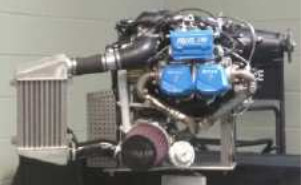
“Rotax 915is with turbo, intercooler, injection and gearbox”
-Of the two-cylinder, two-stroke engines, it seems that the one that remains asked for most is the 582 (Mod.99).
-It delivers 65 CV at 6,500 rpm. weighing 29 kg only. This gives us a power to weight ratio of less than half the common idea of 1 Kg per 1 CV.
-This is where the performance of the engine itself enters and that in two-stroke engines each piston gives a work stroke in each turn. Also less weight due to the absence of camshaft, rods, rocker arms and valves. The cylinder heads are simple.
-It is offered with three types of gear, B, C and E.
-The "B" unit offers a propeller reduction of 2'58 to 1.
.The "C" unit can be delivered with four ratios: 2'62 / 3.0 / 3.47 and 4.0 to 1.
-And the “E” with the same reduction ratios as the “C”.
Engines of ROTAX
Model: 185
Arquitecture:
Cooling:
Total Displacement:
Bore / Stroke: x
Power:
Weight:
Model: 277
Arquitecture:
Cooling:
Total Displacement:
Bore / Stroke: x
Power:
Weight:
Model: 377
Arquitecture:
Cooling:
Total Displacement:
Bore / Stroke: x
Power:
Weight:
Model: 447
Arquitecture:
Cooling:
Total Displacement:
Bore / Stroke:
Power:
Weight:
Model: 462
Arquitecture:
Cooling:
Total Displacement:
Bore / Stroke: x
Power:
Weight:
Model: 501
Arquitecture:
Cooling:
Total Displacement:
Bore / Stroke: x
Power:
Weight:
Model: 503
Arquitecture:
Cooling:
Total Displacement:
Bore / Stroke: x
Power:
Weight:
Model: 508
Arquitecture:
Cooling:
Total Displacement:
Bore / Stroke: x
Power:
Weight:
Model: 532
Arquitecture:
Cooling:
Total Displacement:
Bore / Stroke: x
Power:
Weight:
Model: 582, 582 Mod.99
Arquitecture:
Cooling:
Total Displacement:
Bore / Stroke: x
Power:
Weight:
Model: 618
Arquitecture:
Cooling:
Total Displacement:
Bore / Stroke: x
Power:
Weight:
Model: 912 series
Arquitecture:
Cooling:
Total Displacement:
Bore / Stroke: x
Power:
Weight:
Model: 914 series
Arquitecture:
Cooling:
Total Displacement:
Bore / Stroke: x
Power:
Weight:
Model: 915 series
Arquitecture:
Cooling:
Total Displacement:
Bore / Stroke: x
Power:
Weight:
Model: HPS Hybrid
Arquitecture:
Cooling:
Total Displacement:
Bore / Stroke: x
Power:
Weight:


